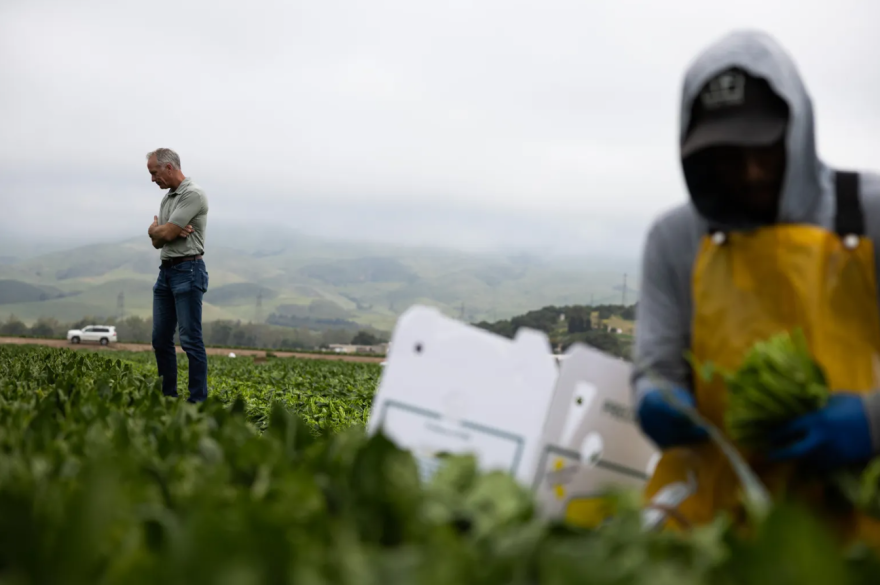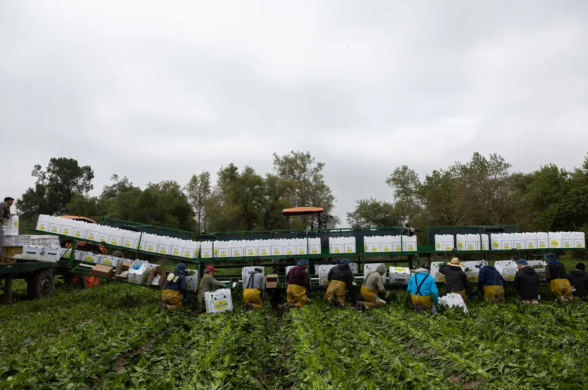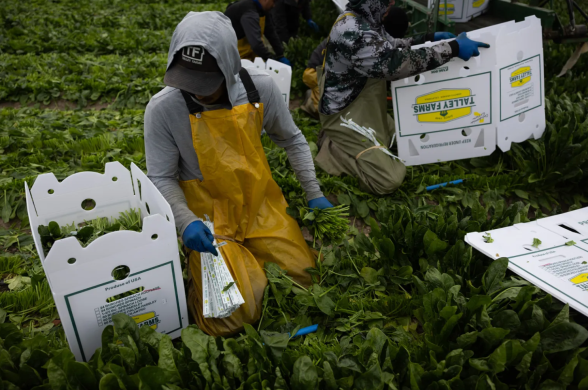Truth matters. Community matters. Your support makes both possible. LAist is one of the few places where news remains independent and free from political and corporate influence. Stand up for truth and for LAist. Make your tax-deductible donation now.
How Trump tariffs could upend California farms, wine businesses and ports

President Donald Trump’s on-again, off-again tariffs are putting many California businesses, jobs and the state budget at risk. They’re affecting not only long-term relationships with trading partners, but an intricate web of ecosystems and supply chains.
The California business owners and groups grappling with the tariffs — wine shop owners, winery founders, farmers — say the precise effects on their industries are unclear so far. They hope there will be an upside.
About this article
This story was originally published by CalMatters. Sign up for their newsletters.
But for those who have a broad view of trade, things look grim.
The Port of Los Angeles and the Port of Long Beach, the busiest ports in North America, both saw first-quarter increases in imports, but declines in exports, year over year.
Gene Seroka, executive director for the Port of Los Angeles, attributed the higher volume of cargo being moved to “front-loading as a hedge against tariffs” during a recent media briefing. But he said his port saw year-over-year declines in exports for the fourth month in a row, “raising concerns for our [agriculture] and manufacturing partners as counter-tariffs on exports begin to take effect.”
Seroka — who said companies have been telling him they are holding back on hiring and capital investments — predicted a slowdown in cargo movement beginning in May, and expects a 10% drop in volume from July until next year. His predictions are already beginning to show up in the port’s import volume.
Some of that may be due to a decline in Chinese imports. On April 9, Trump raised his tariff on China to 145%, although he later exempted certain electronics, such as laptops and smartphones. China responded on April 12 with 125% tariffs on U.S. products. Chinese goods represent 40% of the imports that pass through the Port of Los Angeles, Seroka said.
A decline in volume will affect port jobs, though he doesn’t anticipate mass layoffs, he said. More than 1.5 million jobs are tied to the two Southern California ports.
The effects of decreased trade will vary for different businesses in the state — even within the same industries.
The California wine industry
A wine merchant in Walnut Creek who sells mostly European wines — on which the president has threatened 200% tariffs — said he’s going to have to make adjustments, like carrying more California wines, or consider closing up shop.
“I’d have to think about whether it’s worthwhile staying in business,” said Igor Ivanov, owner of wine shop Vinous Reverie. He added that the tariff issues are just the latest of the wine industry’s woes, which include the fact that people just aren’t drinking as much alcohol as they used to.
On the other hand, increased tariffs on European wine could help boost California wine.
Natalie Collins, president of the California Association of Winegrape Growers, said tariffs on competing wines could help local wine growers.
Bruce Lundquist, co-founder of Rack & Riddle, which he said is the largest custom producer of sparkling wine in the nation, agreed with Collins: “I wish Americans would look at wines grown in their backyard.”
Lundquist said so far Healdsburg-based Rack & Riddle is OK — the company is stocked up on supplies that he orders from different places, both in and out of the country. But he can’t say what his winery and retail clients might be going through. Lundquist worries about tariff uncertainty dragging on, say through next year.
“There would have to be a reckoning if this thing were to go on,” he said. “It’s already hard enough to run a winery.”
What’s at stake as the U.S. wine industry grapples with tariffs: $86 billion in annual sales, U.S. Census Bureau data said. California exported $1.3 billion worth of wine in 2022, per the California Department of Food and Agriculture.

Even if the wine produced in this country stays here, tariffs mean winemakers face higher costs on everything from bottles — glass mostly imported from China — to labels and corks, to metal posts and wooden stakes for the vines. As for U.S. wine exports, 95% of those come from California, says Gino DiCaro, spokesperson for the Wine Institute.
And 35% of exports go to Canada, which now has a serious don’t-buy-American, don’t-go-to-America campaign in effect because of the U.S. president’s threats about tariffs and annexing Canada.
Canadians "are voting with their feet, and there's a real sense of betrayal and a sense of shock,” said Rana Sarkar, consul general of Canada in San Francisco. “Economic crisis within Canada will no doubt ensue from this, but it will also be deeply painful in the United States.”
California recently became the first state to sue the Trump administration over tariffs. Gov. Gavin Newsom said the tariffs’ trade and geopolitical effects are “outsized,” while Attorney General Rob Bonta said the president bypassed the power of Congress to tax and regulate commerce by declaring a national emergency. California’s lawsuit seeks to pause the tariffs immediately.
But in some cases, the damage is already done. The office of U.S. Rep. Mike Thompson, a Democrat whose district includes Napa’s Wine Country, shared anonymized anecdotes from winery owners and managers, who the congressman’s staff said are afraid to go on the record. Thompson’s constituents say their Canadian business partners have canceled hundreds of thousands of dollars worth of orders, and that potential sales to Mexico or the European Union are on hold. One medium-size winery in St. Helena told Thompson’s staff that since the tariffs Trump imposed during his first term, it has lost 90% of its business with China and is no longer seeking to sell there: “China has turned to other wine regions across the globe and we believe rebuilding this market will take over 20 years.”
In addition, “the uncertainty itself has had damage, even though we [may not] get the tariffs,” said Daniel Sumner, economics professor and director of the University of California Agricultural Issues Center at UC Davis.
California and other producers of agricultural products want to be able to tell customers they’re reliable suppliers, Sumner said. “But you can’t do that if prices can go up. That’s a real problem,” he said.
Sumner added: “A major concern for any industry is the increased likelihood of a global recession and slower growth in general.”
Investment banks and economists have said a recession is likely. Citing Trump’s tariffs, the International Monetary Fund has slashed its forecast for U.S. and global economic growth this year.
Farming: Almonds, dairy and other crops
Ryan Talley is vice president of Talley Farms in Arroyo Grande, in San Luis Obispo County, which was started in the 1940s by his grandfather. Now his children are the fourth generation of his family to work for the farm, which grows a few dozen crops.

Talley said his medium-size farm is still able to sell spinach to Canada, but he’s concerned about being able to sell bell peppers to the country, because harvest season for those won’t come until August through November. He hopes the United States-Mexico-Canada Agreement will protect those sales — but Trump has threatened tariffs on Canada and Mexico a few times.
Talley Farms’ other crops — including cabbage, kale, lettuce and corn — are distributed domestically but are highly perishable. Talley said that means it’s tough to adjust operations to any tariffs because of changes to fuel, fertilizing or other supply costs.
“We don’t have months to wait something out,” he said. “We have to continue our operations at the intensity that we currently farm.” He added that “we’re going to have to take those rising prices and deal with it the best we can.”
In addition, Talley worries that one possible effect of tariffs is a glut of domestically grown crops. “If the majority of U.S. farms weren't able to export their product, everything would stay here, which would completely flood the market and send prices down,” he said. “It would be great for consumers [in terms of prices] but in the end it would hurt the American farmer.”
But Talley’s biggest concern is his farm’s workers, who could be affected by Trump’s stated intent of mass deportations: “I can withstand an increase in fuel prices and fertilizer prices and regulatory burden to an extent. But if you take away my labor overnight, it would be hard for us.”
It’s almost impossible to find a part of California agriculture unaffected by Trump’s tariffs.
Shawna Morris, executive vice president of trade policy at the National Milk Producers Federation, said she is concerned about California’s dairy exports to Mexico, including cheese. The other really big market for California dairy products is China, which has already “pulled the trigger” on retaliatory tariffs, Morris said. California’s dairy exports totaled $3.2 billion in 2022.
California’s biggest export, almonds, had $4.7 billion in foreign sales in 2022. Their longer shelf life is a plus, said almond farmer Jenny Holtermann, in Kern County. “We harvest once a year, then [our processor partners] sell throughout the year,” she said. “The tariffs won’t affect us instantly.”
Holtermann has experience from the tariffs the president imposed during his first term. She would not share specific numbers for her own farm — which has also been in her family for four generations — but acknowledged those tariffs hurt the almond industry, which is “just now starting to rebound.”
Almond growers saw their prices drop from $2.50 a pound to $1.40 a pound after Trump’s tariffs in 2018, according to research from the University of California Giannini Foundation of Agricultural Economics.
Holtermann said farmers’ costs have only gone up, so her farm has adjusted by using less fertilizer, buying fewer tractors or letting trucks run a little longer before replacing them.
But she said she thinks the president’s tariffs are part of “a long-game approach … to get our country back to the economic powerhouse we’re supposed to be.”
Besides, Holtermann is counting on a couple of things. One is California almonds’ dominance: The state produces 80% of the world’s almonds, says the Almond Alliance.
The other thing she’s hoping for is another possible federal bailout, which reportedly has been discussed by the Trump administration. During the Trump 1.0 trade war, the federal government provided farmers with “market facilitation funds” of $23 billion to try to offset the business they lost as a result of China’s retaliatory tariffs on the United States, the Government Accountability Office said in a 2021 report.
The U.S. Department of Agriculture has not responded to CalMatters’ questions.
Those funds helped her farm last time, Holtermann said, so she’s hoping for more of the same. “I do know he supports agriculture,” she said of the president. “He’s had a lot of meetings with agriculture organizations.”
Still, she expects to take a short-term hit from tariffs this time around, including losing business from certain countries. “I’m not naive,” Holtermann said. “I’m sure we will miss a portion of that market share.”
But Shannon Douglass, president of the California Farm Bureau, is concerned about getting global buyers to return once they switch to other sources. “We know the last round, almonds and pistachios saw a 20% drop in exports,” she said. “Once they have moved it can take a long time to get those markets back.”
This article was originally published on CalMatters and was republished under the Creative Commons Attribution-NonCommercial-NoDerivatives license.












